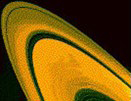

 |
|
 |
Saturn
Description Saturn is a gas giant. It's structure is very similar to Jupiter's. The core is composed liquid rock. Next comes a layer of liquid hydrogen. It is under such high pressure that the nature of the hydrogen changes, and is able to conduct electricity like metal. This generates the planet's magnetic field. The layer on top of this is ordinary liquid hydrogen. Next, the hydrogen thins out into the gaseous atmosphere. It is composed of mainly hydrogen and helium with trace amounts of methane, water, ammonia, and hydrogen sulfide. Interestingly, Saturn creates some of its own heat, but in a much different way than Jupiter. Scientists believe that the hydrogen and helium are slowly separating out, like vinegar and oil when left to sit. In Saturn's case, the heavier helium is slowly making its way through the hydrogen, generating heat (from friction) as it goes. Saturn has something like Jupiter's Great Red Spot, but it is a Great White Spot. Nothing is currently known about the phenomenon, but it is probably similar to the Great Red Spot in the way it has formed. Besides this, Saturn's outer atmosphere is not nearly as turbulent as Jupiter's. This is because, being about two times farther away from the sun, it receives approximately 1/4 as much as energy from it. Less energy means that there is less to power atmospheric phenomenon. Unique Characteristics Saturn has two main unique features. First, it is the least dense of all the planets. If there were a bathtub big enough to fit Saturn in, the planet would float. 
Second is Saturn's magnificent ring system. This system has four sections. The farthest out, F, was discovered during the Voyager mission. Moving towards Saturn, next is the A section, and this section makes up about half the diameter of the entire system. Then comes the Cassini Division, between A and B, which is the large gap visible in most photographs. Next is the B ring, which has raised parts, caused by the planet's magnetism. These appear as spokes. In-between B and C, there is a small division called Enck's Division. The C ring is transparent. Farther in, there are very small ring particles which are slowly spiraling in towards the planet. The rings were probably formed relatively recently - several thousand years ago - when two of Saturn's satellites crashed together. The ring systems of the other gas giants probably formed the same way, only much earlier, which is why they are mostly gone; most of their rings have fallen into their planet's atmosphere. In about 100,000,000 years, Saturn's rings will probably be gone, too. Mythology Saturn is named for the Roman Lord of the Rings. He is the father of Jupiter. Saturn overthrew his evil father Uranus in order to rule. Jupiter later overthrew Saturn because Saturn ate his children. He ate them because he knew that one day one of them would take his power. Jupiter had managed to get away. Data for the Planets:
|